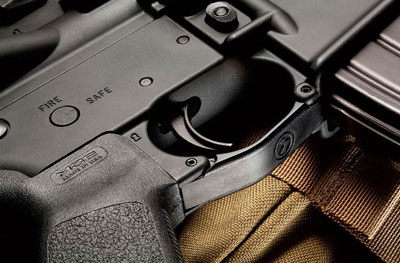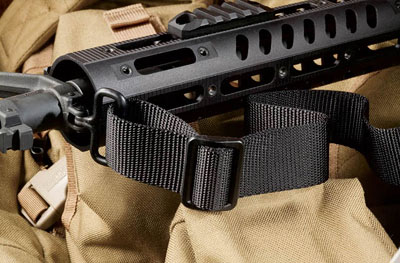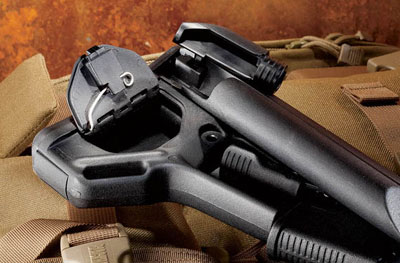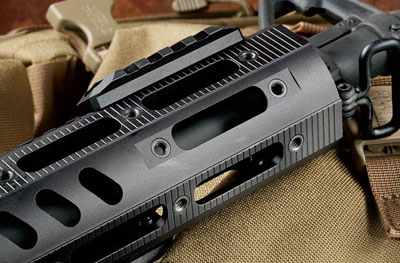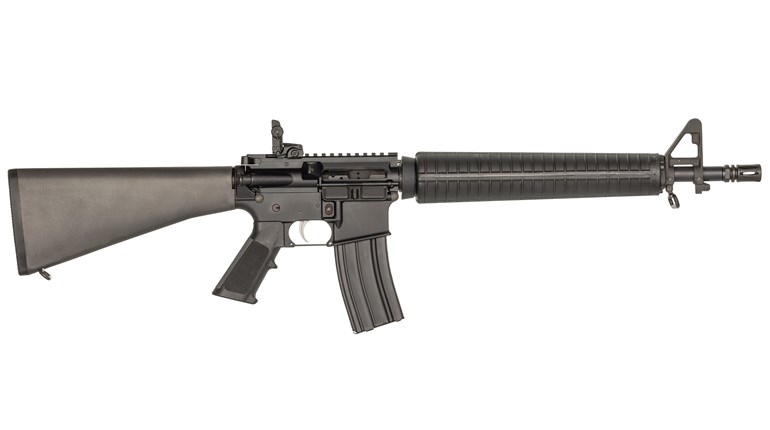
Thanks to its building-block modularity, you can pretty much equip an AR for any situation—bad guys at 5 yards, prairie dogs at 500, zombies everywhere in between—limited only by your imagination. (With all the apocalyptic talk lately, perhaps "preparation" is a better word.) There is, however, one little detail that gets in the way: that fun-stifling thing known as your budget. Swap too many components and accessories around, and you will have thrown enough coin at one AR to have two.
So in the interest of both economy and practicality, it makes good sense to have a single AR that can tackle a variety of tasks without having to change a thing about it. Avid students of the AR may already have such a rifle, but it likely took them several years of thinking and tweaking, buying and selling before arriving at the "ultimate." The rest of us should simply check out the new DPMS Tac2, as it highlights the AR platform's flexibility—with no parts swapping required.
The Long and Short of It
DPMS builds the Tac2 around a rifle-length gas system, which is the technical ticket to the carbine's adaptability. The gas tube extends a full 15.125 inches from the carrier key before ending in the gas block. This provides two advantages: an appreciable increase in sight radius and a theoretical decrease in felt recoil.
Since the gas block also includes the front-sight post, positioning the assembly farther down the barrel adds several inches of distance between it and the rear aperture. The sight radius on a standard M4-style carbine with an A2-type front sight at the end of a carbine-length gas system is in the neighborhood of 14.5 inches. On the Tac2, however, the distance between the aperture of the Magpul MBUS rear sight and the front post is almost 20 inches, an increase of about 38 percent.
Unfortunately, this doesn't mean you'll be 38 percent more accurate with the Tac2. In general, though, a longer sight radius allows for a more precise sight alignment. Slight shifts in the position of the front-sight post relative to the rear aperture are more noticeable the farther the two are apart. It's easier to spot misalignment.
Achieving a rifle-length sight radius with an A2-type front sight/gas block usually requires a barrel of 20 inches or more. But the Tac2 follows the trend set by "Dissipator" carbines by providing the sight radius of a rifle-length system on a handy 16-inch barrel—only with a substantial shift. Most Dissipator setups use a carbine- or mid-length gas system with a low-profile gas block hidden beneath a rifle-length fore-end. The A2-type front sight/gas block resides on the barrel where the gas port for a rifle-length system would normally be located, but it's not actually part of the gas system. It's only there to provide a front sight.
The A2-type front sight/gas block on the Tac2, however, is the functioning gas block, because the carbine has a true rifle-length gas system with the gas port located 13 inches down the barrel. This offers the potential for reduced recoil, as the pressure produced by expanding gases at the port of a rifle-length system is substantially lower than at the port of a shorter gas system. The force that the gases impart to the bolt-carrier group, and eventually your shoulder, is less violent. While felt recoil from an AR in 5.56 NATO isn't exactly punishing, less of it means more control and faster recovery between shots.
That's assuming, of course, the gas system functions reliably. The Tac2's direct-gas-impingement operating system requires just the right amount of gas at just the right pressure to unlock the bolt at just the right time and initiate cycling. The location of the gas port plays a key part in this balancing act, and it is normally dictated by barrel length because of a factor known as dwell time. Dwell time is the period during which a fired bullet remains in the barrel after passing the gas port and before exiting the muzzle. While the bullet "dwells" in the barrel, the only place for the expanding gases to go is through the gas port and into the operating system.
Manufacturers traditionally pair carbine-length gas systems with carbine-length barrels and rifle-length systems with rifle-length barrels because reliability has been proven. A short gas system on a long barrel has the potential to be "over-gassed" due to high gas pressure at the gas port and increased dwell time. This could lead to excessive recoil, difficult extraction, broken parts and other headaches. The opposite is true for a long gas system on a short barrel—there may not be enough gas entering the tube at a high enough pressure to make the gun run. (Mid-length gas systems offer a compromise, but that's another story.)
DPMS bucks the status quo and avoids potential problems by increasing the size of the gas port in the Tac2's barrel from .070 inch in diameter to .113 inch. The larger gas port makes up for the lower gas pressure and shorter dwell time by allowing more gas to enter the system. It's like the bolt-carrier group is being pushed with two hands instead of being slapped with one. Again, the advantage is a decrease in felt recoil, along with less stress on the bolt-carrier group.
Extended Benefits
The Tac2's rifle-length gas system provides more room between the upper receiver and the gas block/sight tower for a fore-end. DPMS makes the most of it by giving the carbine a rifle-length M111 free-float tube. As far as looks go, the M111 fore-end is the coolest thing on the Tac2, but its length offers more benefits than can be appreciated by the eyes.
The M111 provides a wealth of options for mounting accessories without the added bulk of full-length rails. Less than 2 inches in diameter, the M111 is drilled and tapped to accept rail sections along its length at the conventional 3-, 6- and 9-o'clock positions. Additional rail-attachment points are located at the 1:30, 4:30, 7:30 and 10:30 marks toward the front and rear of the fore-end. Save for the integral, full-length top rail, you can add rails where you need them and remove them where you don't, choosing from 22 locations in all. DPMS provides two, 2.5-inch rails and one, 4.5-inch rail with the Tac2.
Where you position the rails, of course, depends on what type of accessories you plan to add to the carbine, but the M111 fore-end also adapts to your shooting style or body size. For example, if you prefer to place your support-side hand at the far front of the fore-end, the M111's extended length gives you plenty of surface area to grasp. Or, if you have short arms and like to use a fore-grip close to the magazine well, move a rail section to the rear of the fore-end.
Although rifle-length fore-ends typically weigh more than shorter versions, DPMS keeps the M111's weight to a minimum with generous, oval-shaped cutouts. The larger ovals do double-duty by helping align the rail sections with the attachment points. They also work with the smaller cutouts to allow air to circulate around the barrel for cooling.
Reaching Out
The Tac2's versatility outshined even the blazing sun during my test sessions. A couple friends and I started by hammering steel using the iron sights. We all enjoyed the benefit of the Tac2's longer sight radius, especially on 8-inch squares of steel at 150 paces.
At close distances, the Tac2's muzzle-heavy balance helped with control when transitioning between multiple paper targets. The carbine was responsive thanks to its compact overall length, but it didn't feel "whippy" like some guns with thin, 16-inch barrels. Muzzle control was particularly apparent when, in the long shadows of the late afternoon, we switched on the LaserMax Uni-Max Green laser riding aboard the fore-end. Rarely did any of us sweep past a target and have to come back to pick it up. Certainly the Magpul ACS buttstock contributed to the Tac2's handling, providing a place for a solid, continuous cheekweld while moving from target to target.
After cleaning the Tac2, the next day I mounted a Leupold VX-6 Multigun 1-6x24 mm scope, traded the fore-grip for a bipod and headed to the 100-yard line for accuracy testing. I was surprised to see the 1:9-inch-twist barrel handled 69-grain bullets as well as, and in some cases better than, 55-grainers. The overall group average for four loads was just shy of 1.5 inches.
Although the Tac2 turned in a respectable performance during accuracy testing, it also made its one flaw apparent. The trigger was, in a word, horrible. Its pull weight wasn't unreasonable, but I wrestled with considerable creep and overtravel.
Naysayers claim a rifle-length gas system is too long for a 16-inch barrel. On the Tac2, it's just right. The carbine digested nearly 500 rounds of six different loads having bullet weights of 55 to 75 grains without a single failure to feed or function. Reliability is paramount whether your carbine is intended for personal protection or for competition. The Tac2 would excel at either of these missions because it's both reliable and versatile.
It's smart planning to have iron sights on your long gun and to know how to use them effectively. The Tac2 gives you a set of irons with a healthy sight radius, plus the option of adding an optic. There is room to set up just about any accessory—several, actually—on the carbine's fore-end the way you want it. Finally, you get the soft-shooting benefits of a rifle-length gas system with the maneuverability of a 16-inch barrel. The DPMS Tac2 may not be able to do it all, but its built-in adaptability goes a long way.
Manufacturer: DPMS; (320) 345-9223, dpmsinc.com
Action Type: Gas-operated, semi-automatic
Caliber: 5.56 NATO
Capacity: 30 rounds
Upper Receiver: Forged 7075-T6 aluminum alloy
Barrel: Button-rifled, 4140 chrome-moly steel; 16 inches
Rifling: 6 grooves, 1:9-inch RH twist
Fore-end: DPMS M111
Lower Receiver: Forged 7075-T6 aluminum alloy
Trigger: Single-stage; 5.9-pound pull weight
Sights: Magpul MBUS flip-up rear, A2-type front
Stock: Six-position, collapsible Magpul ACS
Length: 34.25 to 38 inches
Weight: 8.5 pounds
Accessories: Two aluminum magazines, rail sections, nylon sling, polymer hard case
MSRP: $1,299
